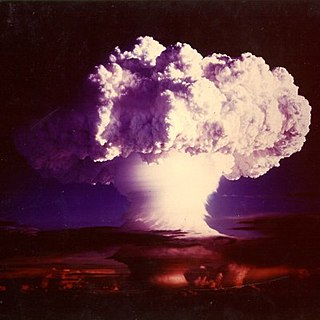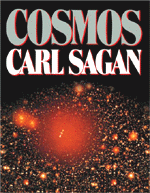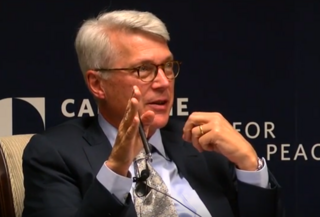
Ann Druyan is an American documentary producer and director specializing in the communication of science. She co-wrote the 1980 PBS documentary series Cosmos, hosted by Carl Sagan, whom she married in 1981. She is the creator, producer, and writer of the 2014 sequel, Cosmos: A Spacetime Odyssey and its sequel series, Cosmos: Possible Worlds, as well as the book of the same name. She directed episodes of both series.

Carl Edward Sagan was an American astronomer, planetary scientist and science communicator. His best known scientific contribution is his research on the possibility of extraterrestrial life, including experimental demonstration of the production of amino acids from basic chemicals by exposure to light. He assembled the first physical messages sent into space, the Pioneer plaque and the Voyager Golden Record, which were universal messages that could potentially be understood by any extraterrestrial intelligence that might find them. He argued in favor of the hypothesis, which has since been accepted, that the high surface temperatures of Venus are the result of the greenhouse effect.

Nuclear winter is a severe and prolonged global climatic cooling effect that is hypothesized to occur after widespread firestorms following a large-scale nuclear war. The hypothesis is based on the fact that such fires can inject soot into the stratosphere, where it can block some direct sunlight from reaching the surface of the Earth. It is speculated that the resulting cooling would lead to widespread crop failure and famine. When developing computer models of nuclear-winter scenarios, researchers use the conventional bombing of Hamburg, and the Hiroshima firestorm in World War II as example cases where soot might have been injected into the stratosphere, alongside modern observations of natural, large-area wildfire-firestorms.

Nuclear warfare, also known as atomic warfare, is a military conflict or prepared political strategy that deploys nuclear weaponry. Nuclear weapons are weapons of mass destruction; in contrast to conventional warfare, nuclear warfare can produce destruction in a much shorter time and can have a long-lasting radiological result. A major nuclear exchange would likely have long-term effects, primarily from the fallout released, and could also lead to secondary effects, such as "nuclear winter", nuclear famine, and societal collapse. A global thermonuclear war with Cold War-era stockpiles, or even with the current smaller stockpiles, may lead to various scenarios including the human extinction.

Mutual assured destruction (MAD) is a doctrine of military strategy and national security policy which posits that a full-scale use of nuclear weapons by an attacker on a nuclear-armed defender with second-strike capabilities would result in the complete annihilation of both the attacker and the defender. It is based on the theory of rational deterrence, which holds that the threat of using strong weapons against the enemy prevents the enemy's use of those same weapons. The strategy is a form of Nash equilibrium in which, once armed, neither side has any incentive to initiate a conflict or to disarm.

Iosif Samuilovich Shklovsky was a Soviet astronomer and astrophysicist. He is remembered for work in theoretical astrophysics and other topics, as well as for his 1962 book on extraterrestrial life, the revised and expanded version of which was co-authored by American astronomer Carl Sagan in 1966 as Intelligent Life in the Universe.

Project A119, also known as A Study of Lunar Research Flights, was a top-secret plan developed in 1958 by the United States Air Force. The aim of the project was to detonate a nuclear bomb on the Moon, which would help in answering some of the mysteries in planetary astronomy and astrogeology. If the explosive device detonated on the surface, and not in a lunar crater, the flash of explosive light would have been faintly visible to people on Earth with their naked eye. This was meant as a show of force resulting in a possible boosting of domestic morale in the capabilities of the United States, a boost that was needed after the Soviet Union took an early lead in the Space Race.

James Barney Pollack was an American astrophysicist who worked for NASA's Ames Research Center.

Human extinction is the hypothetical end of the human species, either by population decline due to extraneous natural causes, such as an asteroid impact or large-scale volcanism, or via anthropogenic destruction (self-extinction), for example by sub-replacement fertility.
Dorion Sagan is an American essayist, fiction writer, poet, and theorist of ecology. He has written and co-authored books on culture, art, literature, evolution, and the history and philosophy of science, including Cosmic Apprentice,Cracking the Aging Code, and Lynn Margulis: The Life and Legacy of a Scientific Rebel.

Cosmos is a popular science book written by astronomer and Pulitzer Prize-winning author Carl Sagan. It was published in 1980 as a companion piece to the PBS mini-series Cosmos: A Personal Voyage with which it was co-developed and intended to complement. Each of the book's 13 illustrated chapters corresponds to one of the 13 episodes of the television series. Just a few of the ideas explored in Cosmos include the history and mutual development of science and civilization, the nature of the Universe, human and robotic space exploration, the inner workings of the cell and the DNA that controls it, and the dangers and future implications of nuclear war. One of Sagan's main purposes for both the book and the television series was to explain complex scientific ideas in a way that anyone interested in learning can understand. Sagan also believed the television was one of the greatest teaching tools ever invented, so he wished to capitalize on his chance to educate the world. Spurred in part by the popularity of the TV series, Cosmos spent 50 weeks on the Publishers Weekly best-sellers list and 70 weeks on the New York Times Best Seller list to become the best-selling science book ever published at the time. In 1981, it received the Hugo Award for Best Non-Fiction Book. The unprecedented success of Cosmos ushered in a dramatic increase in visibility for science-themed literature. The success of the book also served to jumpstart Sagan's literary career. The sequel to Cosmos is Pale Blue Dot: A Vision of the Human Future in Space (1994).

A nuclear explosion is an explosion that occurs as a result of the rapid release of energy from a high-speed nuclear reaction. The driving reaction may be nuclear fission or nuclear fusion or a multi-stage cascading combination of the two, though to date all fusion-based weapons have used a fission device to initiate fusion, and a pure fusion weapon remains a hypothetical device. Nuclear explosions are used in nuclear weapons and nuclear testing.

Georgy Sergeyevich Golitsyn is a prominent Russian scientist in the field of Atmospheric Physics, full member of the Academy of Sciences of the USSR since 1987, Editor-in-Chief of Izvestiya, Atmospheric and Oceanic Physics, ISSN 0001-4338, member of the Academia Europaea since 2000. 1990-2009 - Director of the A.M. Obukhov Institute of Atmospheric Physics, RAS, Moscow, Russia. He is a member of the princely house of Golitsyn. His father is the Russian writer Sergei Mikhailovich Golitsyn.

Scott Douglas Sagan is the Caroline S.G. Munro Professor of Political Science at Stanford University and co-director of Stanford's Center for International Security and Cooperation (CISAC). He is known for his research on nuclear weapons policy and nuclear disarmament, including discussions of system accidents, and has published widely on these subjects.
Jon Lomberg is an American space artist and science journalist. He was Carl Sagan's principal artistic collaborator for more than twenty years on many projects from 1972 through 1996. In 1998, the International Astronomical Union officially named an asteroid in recognition of his achievements in science communication. He was NASA's Design Director for the Golden Record on the Voyager spacecraft; the cover he designed is expected to last at least a billion years.

A nuclear holocaust, also known as a nuclear apocalypse, nuclear annihilation, nuclear armageddon, or atomic holocaust, is a theoretical scenario where the mass detonation of nuclear weapons causes widespread destruction and radioactive fallout. Such a scenario envisages large parts of the Earth becoming uninhabitable due to the effects of nuclear warfare, potentially causing the collapse of civilization, the extinction of humanity, and/or the termination of most biological life on Earth.

Owen Brian Toon is an American professor of atmospheric and oceanic sciences. He is a fellow at the Laboratory for Atmospheric and Space Physics (LASP) at the University of Colorado Boulder. He received an A.B. in physics at the University of California, Berkeley in 1969 and a Ph.D. in physics at Cornell University in 1975 under Carl Sagan. His research interests are in cloud physics, atmospheric chemistry, and radiative transfer. He also works on comparing Earth and other planets such as Venus.

Richard Peter "Rich" Turco is an American atmospheric scientist, and Professor at the Institute of the Environment, Department of Atmospheric and Oceanic Sciences, University of California, Los Angeles. He won an award in 1986, from MacArthur Fellows Program.
Jeannie Peterson was editor-in-chief of Ambio, a journal of the human environment published by the Royal Swedish Academy of Sciences in Stockholm, author of "The Aftermath: The Human and Ecological Consequences of Nuclear War" which was written for Ambio, and served with the United Nations in several capacities including Deputy Director of Public Information and External Relations, country director of United Nations Population Fund in the Philippines, as a United Nations peacekeeper dealing with political issues during the Serb-Croat wars in the former Yugoslavia, and at United Nations headquarters addressing global population and environmental issues.

Nuclear famine is a hypothesized famine considered a potential threat following global or regional nuclear exchange. It is thought that even subtle cooling effects resulting from a regional nuclear exchange could have a substantial impact on agriculture production, triggering a food crisis amongst the world's survivors.
















